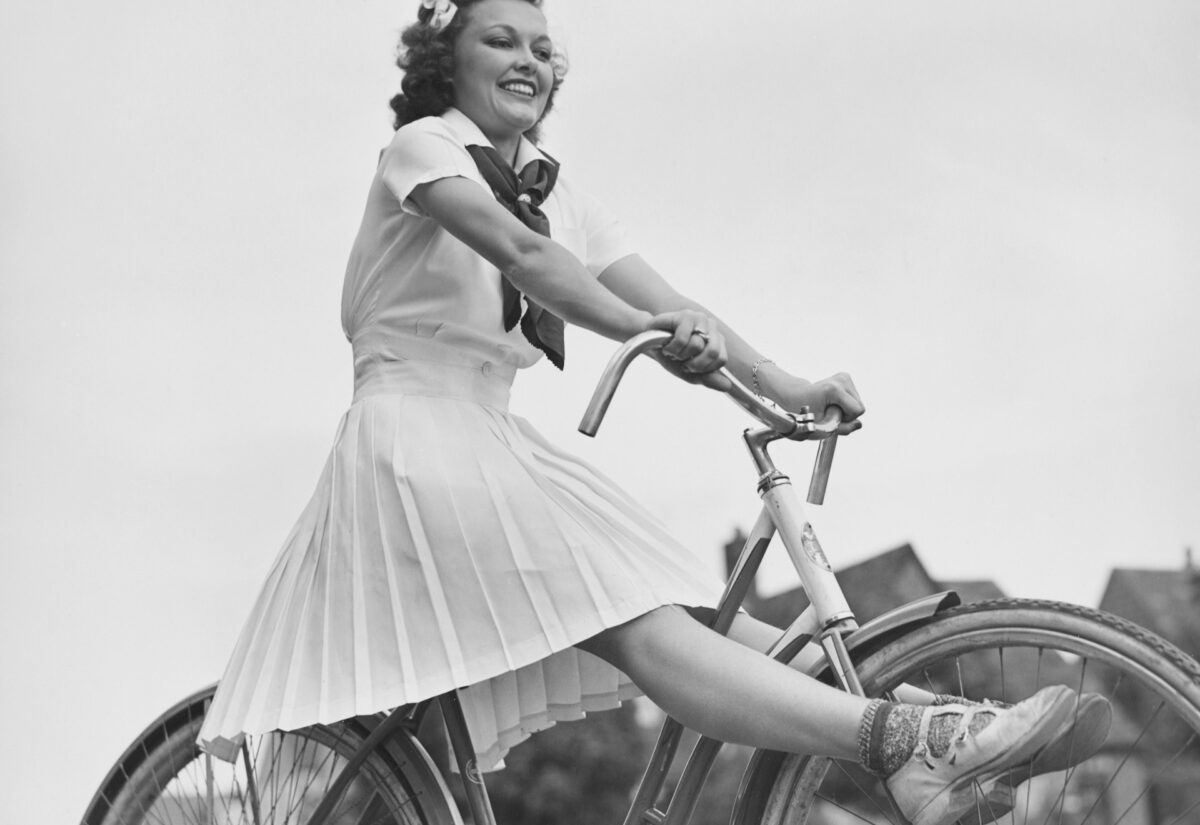 Unsplash/Getty
Unsplash/GettyWhen we think of WWII, we usually focus on battles, politics, and major historical events. However, the war had a huge impact on everyday life, especially in how people dressed. With resources stretched thin, materials rationed, and entire industries repurposed for the war effort, clothing had to adapt in surprising ways. Out of necessity came creativity, and some fashion changes that outlived the war by decades. Here are some of the more unexpected ways WWII reshaped everyday fashion in Britain and beyond.
Trousers became everyday wear for women.
Before the war, it was still considered unusual—or even socially inappropriate—for women to wear trousers in public. Skirts and dresses were the expected norm. But when millions of women entered the workforce to fill roles left vacant by enlisted men, priorities shifted. In factories, on farms, and in civil defence work, skirts were simply impractical.
The Ministry of Information actively promoted the image of the capable, trouser-wearing female worker. Clothing manufacturers followed suit, producing trousers tailored to the female figure. Though many women returned to traditional clothing styles after the war ended, the trousers trend didn’t disappear. The wartime normalisation of women in trousers paved the way for later fashion icons like Katharine Hepburn and Audrey Hepburn to wear them publicly, stylishly, and unapologetically.
Nylon disappeared, and legs got painted.
Nylon stockings had only just become affordable and fashionable before the war hit, but they quickly became a luxury item when nylon production was redirected to the military. The synthetic fabric was desperately needed for parachutes, ropes, and webbing. With no new stockings available, women had to improvise.
Some used gravy browning or tea to tint their legs, and many even drew a dark line down the back of the calf to mimic the seam of real nylons. Leg makeup was so popular that some chemists began stocking specialised products for it. You can read more about this unusual workaround in Perfume Passage feature, which explains how women who used these techniques daily.
Uniforms started influencing street style.
Military-style clothing didn’t stay on the battlefield. Wartime necessity drove the British government to introduce the Civilian Clothing Order in 1941, which established the Utility Clothing Scheme. The idea was to reduce waste and ensure a fair distribution of garments. Clothes were limited in design—no fancy trimmings, excessive buttons, or fabric-heavy pleats. Despite these limitations, designers like Norman Hartnell were brought in to make Utility clothing not only practical but stylish.
The clean lines, structured tailoring, and subdued palettes of military uniforms started filtering into civilian fashion. These design elements stuck around well after the war, shaping the sharp silhouettes of the 1950s and feeding into mid-century minimalist fashion.
The rise of the siren suit is undeniable.
The siren suit was a one-piece zip-up garment that could be pulled on quickly during air raids. It was popularised by none other than Winston Churchill, who wore them frequently, even in front of visiting dignitaries. Designed for comfort and speed, the suits were ideal for nights spent in air raid shelters and Anderson shelters.
Women also adopted versions of the siren suit, especially for home use. These practical garments became early prototypes for jumpsuits, loungewear, and eventually onesies. In some ways, they were the original version of the “dressing for comfort” trend we see today.
Rationing changed how clothes were made.
Clothing rationing in Britain began in 1941, and every person was issued a coupon book that limited how much they could buy. The “make do and mend” philosophy became a national campaign, encouraging people to repair worn garments, repurpose fabric, and sew at home.
Sewing patterns were distributed via women’s magazines, and community sewing circles helped people swap skills and materials. The Utility Clothing Scheme further standardised designs and fabric usage to ensure clothes were simple, hardwearing, and widely accessible. The Imperial War Museums has more detail on this scheme, including how it influenced both form and function in wartime fashion.
Accessories got a wartime twist.
With leather and metals being prioritised for the military, traditional accessories became hard to find. People began making their own, often using unconventional materials like wood, bakelite, and even repurposed scrap metal from downed aircraft. Handmade brooches from aircraft aluminium, often in patriotic or romantic shapes, became popular keepsakes and tokens of resilience.
Belts, bags, and shoes were also affected. Cork or wooden soles replaced leather, and handbags were often knitted or crocheted from leftover yarn. These changes made fashion more handmade and personalised—a trait that endured in post-war craft culture.
Hairstyles got bigger and more elaborate.
When clothes were limited, hair became a key way to express personal style. Victory rolls became iconic: large, sculpted curls often paired with bright lipstick and carefully plucked eyebrows. These weren’t just stylish—they were practical, too. Hairstyles kept hair tidy and out of the way in industrial settings.
Headscarves became a staple, both to protect hair from machinery and as a nod to the ‘Rosie the Riveter’ style of female empowerment. Some women even used scarves to cover up when shampoo or haircuts were hard to come by.
Men’s fashion slimmed down.
Men’s tailoring was also shaped by wartime limitations. Rationing discouraged double-breasted suits, wide lapels, or pleated trousers. Instead, single-breasted suits with narrower cuts became the standard. Waistcoats disappeared from many wardrobes, and cuffed trousers were discouraged.
This leaner silhouette influenced post-war menswear, especially in Britain, where tailoring remained modest and practical into the 1950s. The streamlined look later gave way to the more rebellious and stylised fashions of mods and rockers, but its origins lie in wartime thrift.
Children’s clothing became more gender-neutral.
With families trying to make do on limited rations, children’s clothing had to be practical and reusable. Gender distinctions blurred out of sheer necessity. Boys and girls were often dressed in similarly cut garments—simple dresses, dungarees, and jumpers that could be easily altered or passed down.
Knitting patterns for children’s clothing became a household essential. Many parents also made soft shoes and jumpers from worn-out adult clothing. This approach to children’s clothes being less gendered and more practical would quietly influence later thinking around what kids should wear.
Post-war fashion rebellion took root.
After years of strict rules, ration books, and Utility clothing, many people—especially younger ones—were ready to reject austerity. The late 1940s and early 1950s saw the beginning of this rebellion. Christian Dior’s 1947 “New Look,” with its full skirts and cinched waists, was an extravagant rejection of wartime restraint, and its impact spread across Europe.
In Britain, black market fashion thrived during the war, and after peace was declared, many rushed to embrace colour, embellishment, and flair. This desire for self-expression set the stage for the fashion revolutions of the 1960s and 1970s, rooted in the frustration and resourcefulness of the wartime years.
WWII was a time of scarcity, adaptation, and resilience, but it was also a turning point in how people related to clothes.
Women claimed space in traditionally male styles. Men’s tailoring changed shape. People learned to sew, mend, and innovate out of necessity. The war may have ended, but the fashion habits it sparked continued to ripple out for decades. What we wore during the war wasn’t just about necessity—it was about identity, resourcefulness, and adapting to a world in flux.



